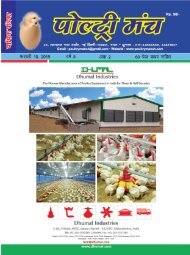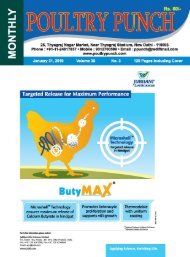POULTRY PUNCH - FEBRUARY 2019
POULTRY PUNCH - FEBRUARY 2019
POULTRY PUNCH - FEBRUARY 2019
- No tags were found...
You also want an ePaper? Increase the reach of your titles
YUMPU automatically turns print PDFs into web optimized ePapers that Google loves.
ARTICLE NEWS<br />
Aflatoxicosis in Chickens: An Overview<br />
Introduction:<br />
Pramod Kumar Soni1, Junaid Kar1, Burhan Ud Din Shafi1, Seema Yadav1<br />
1. PhD Scholar, Indian Veterinary Research Institute- Izatanagar, Bareilly, (U.P.) 243122<br />
Aflatoxins (AF) is a class of mycotoxins, produced by fungal species of the genus Aspergillus (flavus and<br />
parasiticus) and Penicillium puberulum, are a major concern in the poultry production that are often found in<br />
the ingredients used to make poultry feed. Foods known to be at a high risk of aflatoxin contamination include<br />
corn, cottonseed, peanuts, sorghum, tree nuts, and wheat. It grows best at temperatures of 80 to 90°F (26.6 to<br />
32.2°C) and can survive in temperatures as low as 40°F (4.4°C). The mold also requires high moisture content<br />
and can emerge with 15% moisture content. There are four main aflatoxins of concern: aflatoxin B1 (AFB1), B2<br />
(AFB2), G1 (AFG1), and G2 (AFG2); AFB1 is the most common and biologically active. The dietary aflatoxins<br />
reduce weight gain, feed intake, and increase feed conversion ratio. Aflatoxin affected bird’s show poor vaccine<br />
response and low antibody titre, as both cellular and humoral immunities are affected. Although numerous<br />
detoxification methods have been tested, none seems able to fulfill the detoxification process. The adverse<br />
effect of aflatoxins depends on the age, species, nutritional status of birds as well as the dose and length of<br />
time it was consumed. Aflatoxicosis refers to poisoning from ingestion of aflatoxins in contaminated food or<br />
feed. Both acute and chronic aflatoxicosis can occur, however, the chronic form is the most prevalent. Chronic<br />
aflatoxicosis occurs as a result of prolonged intake of low levels of aflatoxins in the chickens’ diet.<br />
Susceptibility<br />
Species:<br />
Ducks, turkeys, geese, pheasant, chicken and other birds. ducks are 10 times more sensitive than chickens,<br />
turkeys are intermediate in sensitivity between ducks & chicks.<br />
Ages:<br />
Young birds are more susceptible than adults and so adult birds are relatively resistant to aflatoxin.<br />
Mode of infection: - Consumption of contaminated foods or litter with aflatoxins.<br />
Favourable Conditions for Growth of the Fungi<br />
Fungi Temperature R.H. Moisture<br />
Aspergillus flavus Range 12-41°C 86-87% More than 10-12%<br />
A. nomius Optimum 25-32°C<br />
Fusarium graminearum<br />
F. sporotrichiosis Below 21°C High humidity 22-25%<br />
Government Regulations for Aflatoxins<br />
The FDA and the EU regulate the number of aflatoxins present in human food, animal feed, and animal<br />
feed ingredients.<br />
For chick starter and grower feeds, corn, and peanut products, excluding cottonseed meal: Must<br />
contain less than 20 ppb<br />
For laying hen feed and other mature poultry: Must contain less than 100 ppb<br />
74 February, <strong>2019</strong>






